How to Integrate PCmover Enterprise with Microsoft's System Center Configuration Manager (SCCM)
PCmover Enterprise can be used in many enterprise automation environments, such as Microsoft's System Center Configuration Manager (SCCM), Ivanti Landesk, Altiris, and PDQ Deploy.
NOTE: This is a scenario with a single SCCM server in a single site, with only a few workstations. Production implementations are always both complex and unique. Planning your testing methodology is critical to avoid impacting other services. For more information on how to implement PCmover in your environment, please contact your Laplink Enterprise Account Representative to schedule a meeting with one of our Enterprise Architects here.
The goal of this example is to perform a zero-touch PCmover File-Based Transfer export from a source machine using a PCmover Policy.
1) Optional: create PCmover Domain account
In a traditional on-premises Domain architecture, the account we use to perform the transfer must be a member of Domain Users and must also have Local Administrator access to the machines to be transferred. While you likely have one or more pre-existing accounts that could serve this purpose (such as the account you use for endpoint software deployment), many of our clients prefer to create a dedicated account to PCmover to permit separate access control and auditing. We recommend this as a best practice.
When creating this account, you should also consider assigning it an email account. With PCmover’s Email Alert capability (which simply sends an email upon transfer completion with support for environment variables, e.g. “Transfer complete from %COMPUTERNAME%”), this mailbox can be used to monitor migrations, creates an audit trail, and can even be used as a source for external scraping to roll the information up into an Enterprise Project Management system.

2) Create network share for the PCmover Client and populate
PCmover Enterprise will run portably by design. For a campus-based automation scenario, install PCmover from the Setup files on any machine to extract the PCmover Client files, and then copy the contents of the C:\Program Files (x86)\Laplink PCmover\PCmover Client folder to a network file share that will be accessible by the account you created in Step 1.
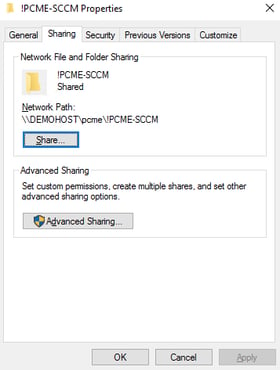
3) Create network share for Transfer Files
The PCmover File-Based Transfer workflow is an export-import process. The data exported from the old environment is held in a “Transfer File” that will later be imported into the new environment. In a campus-based automation scenario, this Transfer File will be held on a network file share.
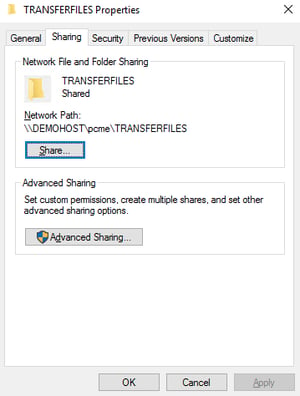
4) Create a PCmover Zero-Touch Export policy and publish to the PCmover network share
Policy configuration is beyond the scope of this document. We can provide you with a sample policy and documentation to describe how it is configured, but again we recommend speaking with one of our Enterprise Architects first rather than attempting a Zero-Touch configuration on your own.
There are several ways to configure this to support your specific scenario, since PCmover Policies support the use of environment variables to specify both the network location and filename. In this example, we will create the transfer file in a simple network share and name it %computername%.pcv, where “.pcv” is our associated file extension for Transfer Files.
Once your policy is configured, simply place it in the PCmover network share at the same level as PCmover.exe, named “policy.pol”, and it will run automatically.
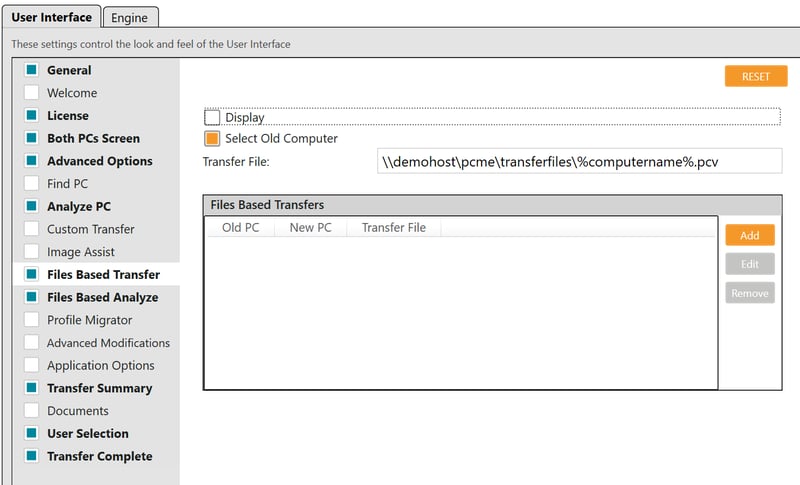
5) Manually test the PCmover configuration
Before configuring the automation environment, manually login to a test machine and run PCmover.exe with your Zero-Touch Policy to be sure that it works as expected, i.e.: without user interaction, a PCV transfer file is created in the Transfer Files network share after running PCmover.exe on the source.
- From this point, we are discussing SCCM actions exclusively, but regardless of your automation system, the goal is simply to schedule a time when the source machines will be instructed to run PCmover.exe from the network share with the zero-touch policy configuration.
- Warning: If you run PCmover simultaneously on a large number of machines without careful planning, you may run into issues such as a saturated network backbone, saturated networking on the file server hosting the Transfer File share, or running out of disk space on that file server.
6) SCCM: Create Device Collection for source machines
Creating a new Device Collection for your test and populating that Collection with only a few PCs will allow you to test without larger potential impact.
For this simple example, we will create a new Device Collection that explicitly chooses only a single machine.
In the Assets and Compliance node, choose a Collection under Devices that contains the machine you will use to test.
Select the machine, right-click, and Add Selected Items to a New Device Collection.
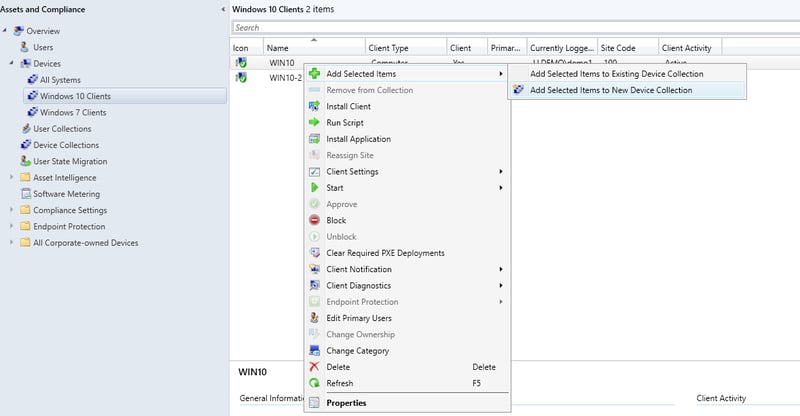
Name the new Device Collection and specify the Limiting Collection.
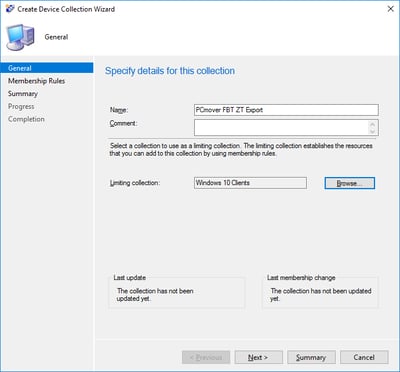
Accept the defaults for Membership Rules and complete the Create Device Collection Wizard.
Select your new Collection to verify membership of the test machine.

Repeat this process if you’d like to test multiple machines at the same time, adding each machine to that new Collection.
7) SCCM: Create Task Sequence
Navigate to Software Library / Operating Systems / Task Sequences / Create Task Sequence
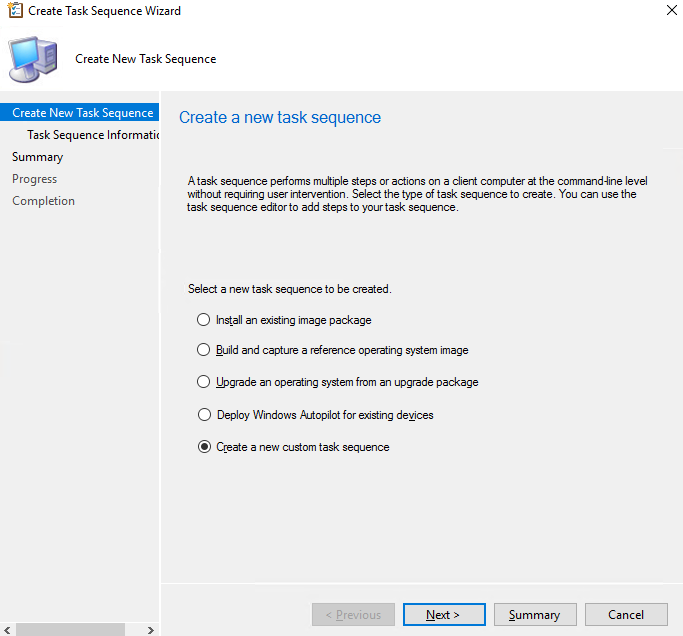
Choose “Create a new custom task sequence,” and click Next.
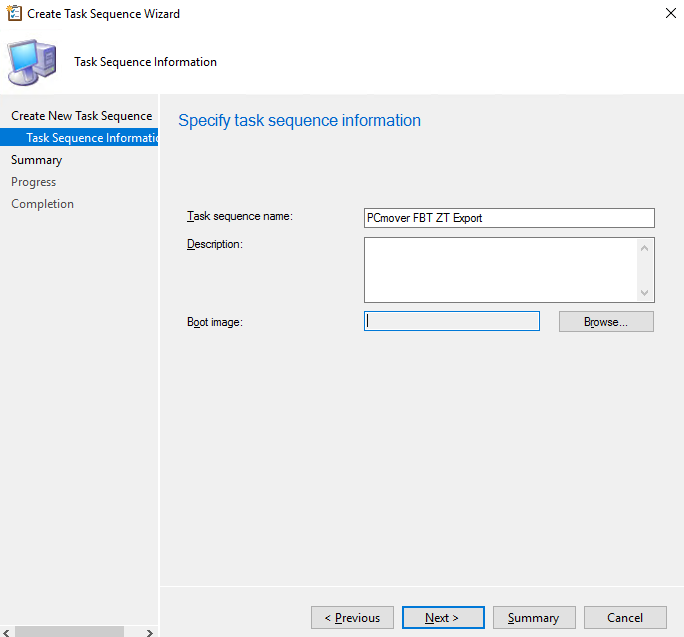
Specify a Task Sequence name and click Next. Click Next again and then Close to complete the Task Sequence Wizard.
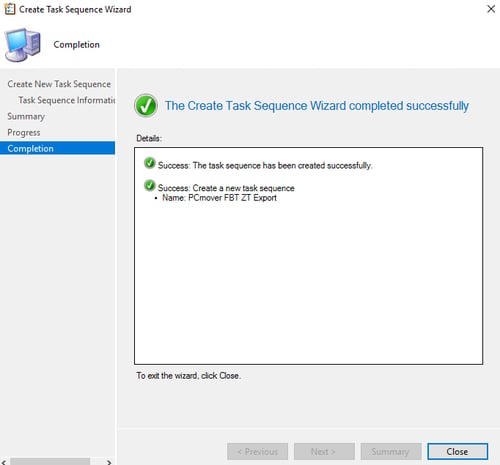
8) Edit the Task Sequence
Right-click the Task Sequence and choose Edit to open the Task Sequence Editor.

Click Add / General / Run Command Line.
Specify a Name and optional Description.
Specify the command line: cmd /c “\\demohost\pcme\!PCME-SCCM\PCmover Client\pcmover.exe”
IMPORTANT: Substitute your network path to PCmover.exe
IMPORTANT: You MUST encapsulate PCmover in a new command processor (cmd /c) or it will not launch.
Check the “Disable 64-bit file system redirection” box
Check the “Run this step as the following account” box and specify the account that you will use to perform the transfer (see Step 1)

Click OK
9) Deploy the Task Sequence
Right-click the new Task Sequence and choose Deploy.
Specify the Device Collection you defined in Step 6 and click OK. Then, click Next on the Deploy Software Wizard.
Change Purpose from the default “Available” to “Required” and click Next.

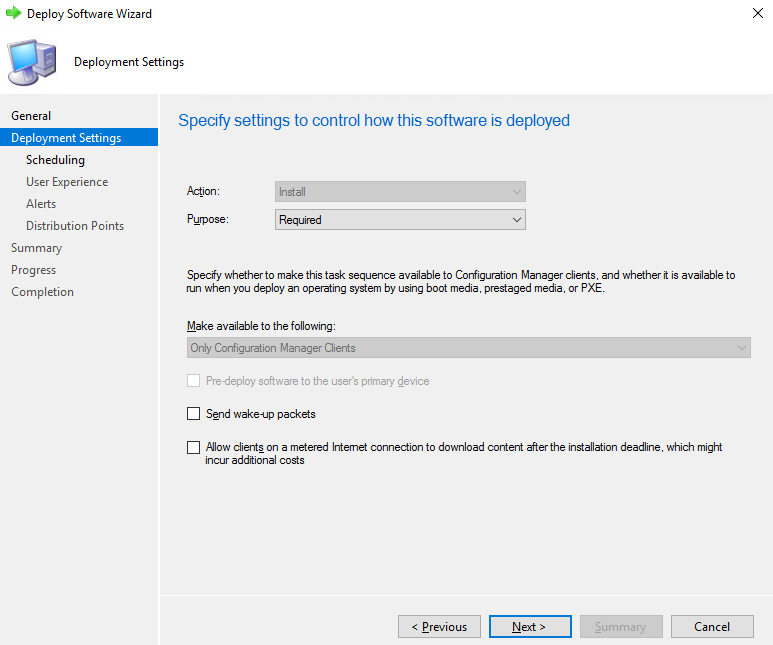
Click the “New” Assignment Schedule button, select the “Assign immediately after this event” button, choose “As soon as possible,” and click OK.
NOTE: For testing purposes, this will cause the Source PC to perform the action right away. In a production deployment, you would create multiple schedules to cascade deployments given your available network bandwidth, file server performance, etc.
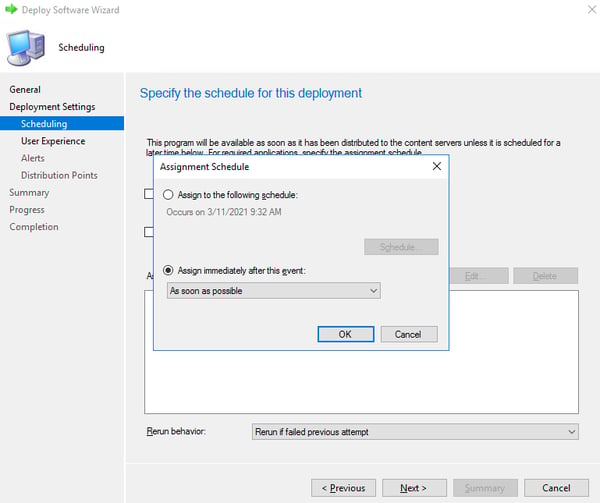
Select the “Rerun behavior” dropdown. Choose “Never rerun deployed program” and click Next.
Accept the defaults for the rest of the screens, clicking Close when the wizard completes successfully.
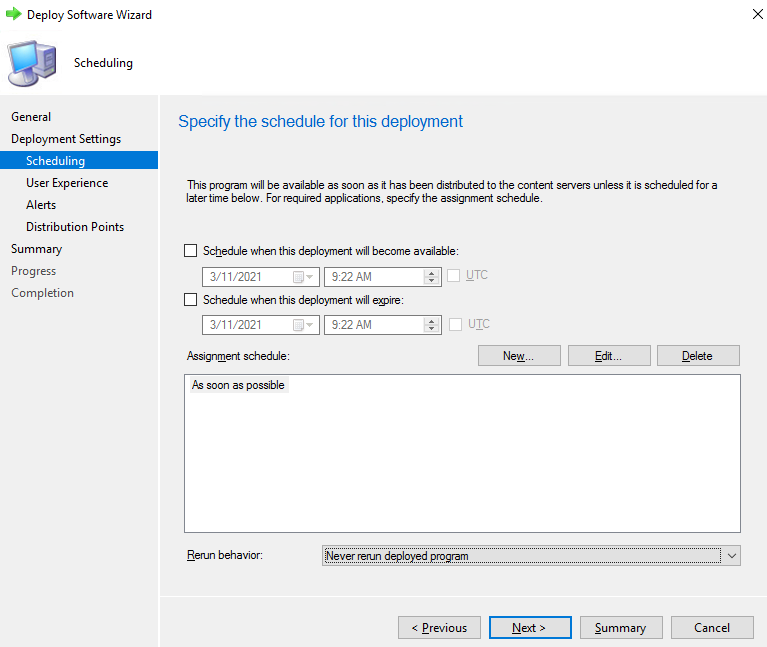
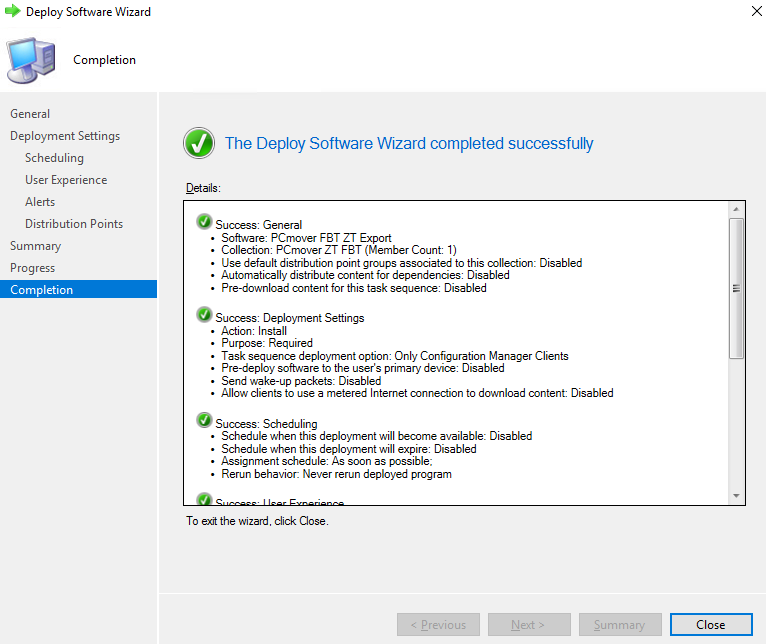
10) Force the Task Sequence to run.
At this point, if you wish, you can simply wait for the client Application Deployments Evaluation to complete automatically. If you want to force the deployment to occur more quickly, choose the Assets and Compliance node, right-click your PCmover device collection under Devices, and choose Client Notification / Evaluate Application Deployments.

Watch the network folder that you created to hold the Transfer Files. If configured properly, once the evaluation cycle occurs and PCmover’s Analysis completes, you should see the Transfer file appear as “In Progress” and then rename automatically to its final name when complete. Note again that in this example we have specified %computername%.pcv in the PCmover Policy configuration.

11) Re-run the test.
If you want to re-run the same test in this configuration, you will need to create and deploy a new Task Sequence. This is easily done by simply copying the existing Task Sequence. This will create a new package with a different Package ID.
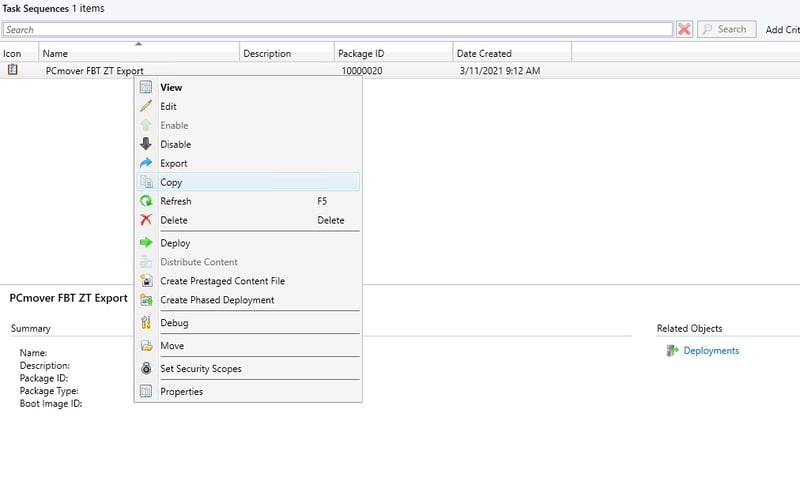
Then delete the original task sequence and deploy the new one with the same actions listed in Step 9.

Conclusion:
PCmover Enterprise Policies offer you granular control over PCmover behavior, including which, if any, steps of the GUI should or should not be shown to create a zero-touch experience that is suitable for integration with any management system that offers remote-launch and scheduling. This simple example, of a zero-touch automated export using the PCmover File-Based Transfer workflow, is the most common automation scenario we see. Other types of scenarios may introduce complexities beyond what we can cover in a simple tutorial like this, so we highly encourage you to book time with one of our Enterprise Architects or contact us before attempting to deploy such a configuration in your environment.



 SCHEDULE A DEMO
SCHEDULE A DEMO